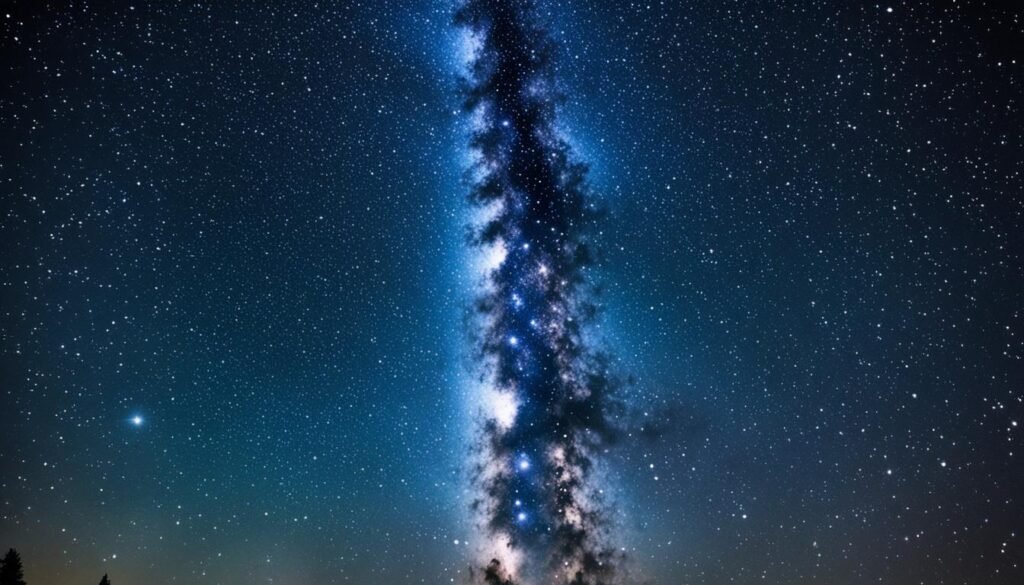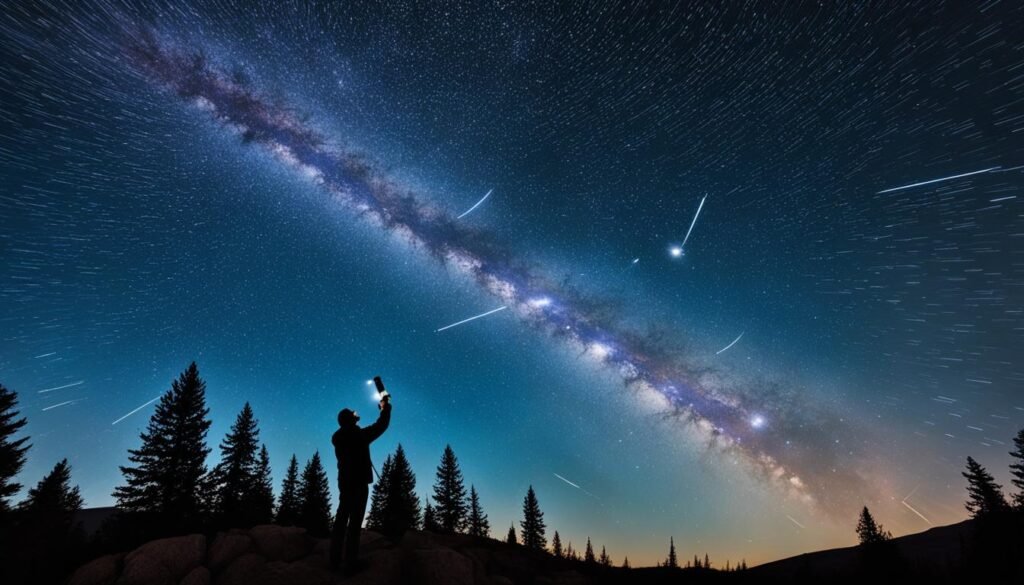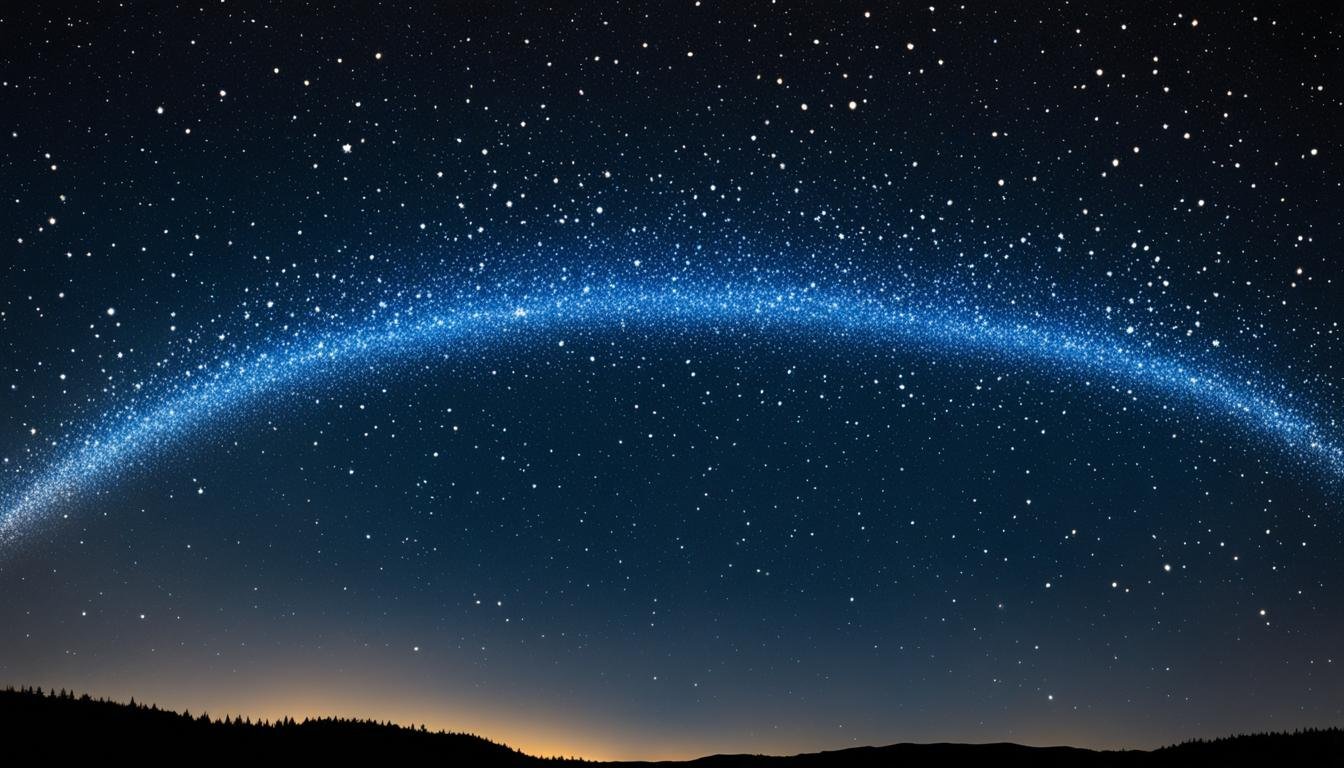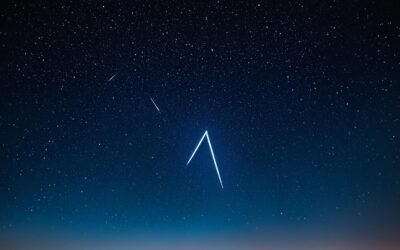As you turn your gaze toward the constellation Camelopardalis, you embark on a journey across the cosmos to one of the night sky’s most captivating features: Kemble’s Cascade Asterism. This linear arrangement of stars, an asterism distinct from formal constellations, captures the hearts of astronomers and stargazers alike. More than just a random cluster, it is a testament to the beauty and complexity of asterisms in astronomy. The cascade boasts over 20 resplendent stars trailing across the celestial canvas, culminating in the open cluster NGC 1502, akin to the climax of a cosmic performance.
The cascade’s story is not just about a wondrous pattern of stars, but also about the intrigue of discovery and observation. With a central star of magnitude 4.9, HIP 18505, Kemble’s Cascade stretches out in an almost perfect linear formation, delineated by stars of magnitudes 7 to 10. Their collaborative twinkle against the canvas of the night gives the illusion of a starry waterfall, beckoning you to explore with your telescope or binoculars. And so, with the constellation Camelopardalis as your roadmap, you’re invited to uncover the celestial secret of Kemble’s Cascade for yourself.
Key Takeaways
- Kemble’s Cascade is a striking linear asterism within the constellation Camelopardalis, not to be confused with formal constellations.
- It features a radiant stretch of over 20 stars, culminating in the open star cluster NGC 1502.
- The asterism is observable through binoculars and telescopes, with the central star HIP 18505 guiding you to its luminary path.
- It serves as a celestial highlight reel showcasing the wonders of asterisms in astronomy.
- Offering both historical significance and astronomical splendor, Kemble’s Cascade is a treasure among nighttime observations.
- Optimal visibility occurs in the months of November and December, making it an end-of-year stargazing spectacle.
Exploring the Enchantment of Kemble’s Cascade Asterism
As you gaze up at the night sky, you might wonder about the charming patterns that stars sketch against the dark canvas. The term asterism definition refers to these recognizable patterns, which, unlike constellations, have no officially marked boundaries. One of these patterns, known for its simplicity and grace, is the Kemble’s Cascade Asterism, set against the northern backdrop of the constellation Camelopardalis.
Defining the Concept: Asterism vs. Constellation
Understanding the distinction between an asterism and a constellation is crucial for astronomy enthusiasts. While constellations are areas of the sky encompassing named star patterns, asterisms are often composed of fewer, brighter stars that form shapes within or across constellations. These famous asterisms captivate stargazers and often serve as celestial guideposts.
Discovering the History Behind Kemble’s Cascade
The history of Kemble’s Cascade adds a layer of intrigue to this asterism. Discovered by Father Lucian Kemble in 1980, the formation was conferred its name and fame thanks to the efforts of Walter Scott Houston, who shared it with the world through his astronomy column. Today, Kemble’s Cascade is a cherished part of astronomical literature.
Why Kemble’s Cascade Remains a Favorite Among Stargazers
There’s a reason why Kemble’s Cascade has become one of the most famous asterisms. Its unique linear drop of stars appears like a celestial waterfall, ending in a bright splash represented by the open star cluster NGC 1502. This awe-inspiring view can be best appreciated during November and December, when it climbs the night sky’s stage to deliver its stellar performance.
Identifying Features of Kemble’s Cascade
As a curious observer of the night sky, you will find Kemble’s Cascade to be a mesmerizing array of stellar magnificence. To truly appreciate its splendor, proper equipment is critical. Both a low-power telescope and binoculars offer a gateway to this cosmic display.
Selecting Optimal Equipment for Viewing
Your choice of telescope or binoculars can dramatically influence your observational experience of the binocular observation of Kemble’s Cascade. A low-power telescope is perfect for witnessing the cascade in its full glory without requiring excessive magnification that would narrow your field of view. Top recommendations include the Meade 6″ f/4.1 LX85 Reflector and the Orion 09007 SpaceProbe 130ST Equatorial Reflector, offering a clear glimpse of the asterism even at 50x magnification.
Constituent Stars: Magnitudes and Arrangement
The constituent stars of Kemble’s Cascade are mainly in the magnitude range of 7 to 8, which are visible to the avid astronomer. These stars form an elegant linear arrangement stretching from the fairly bright central star HIP 18505. Also nestled within are fainter stars, some reaching magnitudes of 10, adding depth and intrigue to the cascade’s linear structure.

Navigating to NGC 1502: The Cascade’s Grand Finale
The cascade culminates magnificently into the open cluster NGC 1502, a spectacular gathering of roughly 25 stars situated some 2,700 light-years from Earth. A telescope with 300mm aperture is sufficient to resolve this stunning cluster and the notable Struve 485 double star. NGC 1502’s location at the southeastern terminus of Kemble’s Cascade makes it a fitting grand finale to your stargazing adventure.
A Step-by-Step Guide to Locating Kemble’s Cascade Asterism
Embarking on a stargazing adventure often leads to the discovery of the night sky’s stellar gems, one of which is the enchanting Kemble’s Cascade. To help you in your quest, here’s a concise guide on how to find Kemble’s Cascade, turning your stargazing session into a celestial triumph.
- Start by scanning the heavens for the iconic ‘W’ of the Cassiopeia constellation, focusing on the bright stars Caph (Beta Cassiopeiae) and Segin (Epsilon Cassiopeiae).
- Imagine a straight line extending from Caph to Segin and continue this line into the constellation of Camelopardalis.
- With this imaginary path as your guide, search for a linear sequence of stars that forms the graceful streaking of Kemble’s Cascade.
Astronomy apps like Stellarium or SkySafari can serve as valuable aids when pinpointing this asterism’s location. Ensure you are well-positioned in an area with minimal light pollution to maximize the visibility of the stars involved.
Dedicate your stargazing to the early evenings of November and December, when Kemble’s Cascade is showcased in its full splendor. This period allows for an optimal viewing experience as the asterism is progressively positioned higher in the northern sky.

Remember, the cascade’s visibility greatly depends on the darkness of your sky. If you find yourself far from city lights and under a clear night, the chances of witnessing this celestial spectacle increase significantly. Follow this stargazing guide, and with a dash of patience, you’ll soon be rewarded with a view of one of the night’s most delicate sights, Kemble’s Cascade.
When to Witness the Cascade: Observing Throughout the Year
If you’re eager to behold the spectacle of Kemble’s Cascade, your calendar’s sweet spots are the early evenings of November and December. These months are heralded as the best visibility months for Kemble’s Cascade, with a night sky that enhances the cascade’s dazzling celestial display. Arm yourself with binoculars or a snug telescope to capture the cascade’s stars gracefully pirouetting into the realm of NGC 1502. The contrast of the night during this period makes the cascade’s alignment quite the stellar performance.
Yet, the circumpolar constellation Camelopardalis envelops Kemble’s Cascade, lending it visibility beyond these premium months. The cascade’s celestial home in the mid-northern latitudes affords it a year-long observational opportunity, weather and local light conditions permitting of course. This circumpolar mystique means that even when the leaves change or snow falls, the cascade can still be found in the canvas of the night sky.
Best Seasons for Visibility: November and December Highlights
The visibility of Kemble’s Cascade achieves its zenith in November and December. Observers are treated to an unrivaled vision of this starry waterfall, making these months cherished periods for astronomers and star-gazers alike. It’s an annual celestial event that welcomes both novice sky watchers and veteran stargazers to a delightful exhibition of cosmic beauty.
Circumpolar Mystique: The All-Year Availability of Camelopardalis
Intriguing in its own right, the circumpolar constellation Camelopardalis peeks at its best in February, around 9 pm, creating a year-round portal to Kemble’s Cascade. Its steady presence in the sky means that with a bit of planning and consideration of local conditions, you can enjoy the cascade without being bound to a seasonal timetable. An astronomical gem, Camelopardalis quietly boasts its treasure, Kemble’s Cascade, allowing enthusiasts to seize the moment when the skies are clear.
Kemble’s Legacy: Other Recognitions and Indigenous Asterisms
The night sky is studded with patterns that have captivated observers for millennia. Among these, Lucian Kemble’s notable observations have left an enduring imprint on contemporary astronomy. Through his telescopic sweeps of the heavens, three configurations bearing Kemble’s name have been immortalized as famous asterisms: Kemble 1, Kemble 2, and Kemble’s Kite. Your stargazing adventures are only enhanced by seeking out these lesser-known yet significant celestial structures.
The Trio of Kemble’s Asterisms: An Overview of Kemble 1, 2, and Kite
As you gaze up at the richness above, it’s fascinating to distinguish the trio of asterisms that honor the Franciscan friar’s legacy. Kemble 1, also named the Cascade, is a celestial waterfall that dances across the firmament. Its counterpart, Kemble 2, found in Draco, hints at the familiar ‘W’ shape of Cassiopeia, reimagined. Then there’s Kemble’s Kite, its four-star quadrilateral boldly delineating a kite’s frame against the backdrop of Camelopardalis.
Each asterism tells its own cosmic story, from the serendipitous discovery of Kemble’s Cascade to the methodical charting of Kemble 2 and the crafting of Kemble’s Kite from lesser-known stars. Together, they offer a window into the depths of the universe and the history of stargazing.
Celestial Honors: The Asteroid Named After Lucian Kemble
Continuing his celestial heritage is the honor bestowed upon a space rock, asteroid 78431 Kemble, a silent rover of our solar system that serves as a testament to Lucian Kemble’s impact on astronomy. Your exploration of the night sky may not capture a glimpse of this distant traveler, but its presence there, among the stars and asterisms he so cherished, is a tribute fitting for someone who illuminated our understanding of the heavens.
| Asterism | Location | Visual Traits | Celestial Honors |
|---|---|---|---|
| Kemble 1 (The Cascade) | Camelopardalis | Stellar Waterfall | First of Kemble’s asterisms, a stargazer’s delight |
| Kemble 2 | Draco | Resembles ‘W’ of Cassiopeia | Imprints Kemble’s legacy in the realm of Draco |
| Kemble’s Kite | Camelopardalis | Kite-shaped pattern | A newer addition to the family of Kemble asterisms |
| Asteroid 78431 Kemble | Main Asteroid Belt | N/A | Named in honor of Lucian Kemble’s contributions |
These celestial honors, both tangible in the form of asterisms and symbolic such as an asteroid’s designation, serve not only as education but as inspiration to keep your eyes fixed on the night sky, searching for the stories and honors bestowed upon the natural philosophers of the past.
Nearby Cosmic Wonders: Expanding Your Stargazing Experience
As you gaze upon the majestic trail of Kemble’s Cascade, remember that this asterism is merely the gateway to a vast universe brimming with cosmic marvels. Beyond the linear sparkle of this starry waterfall lies a treasure trove of deep-sky curiosities, ready to bedazzle avid stargazers. The skies around the constellation Camelopardalis, while seemingly serene, harbor celestial spectacles that can transform an ordinary night into a profound deep-sky observation odyssey.
Diving Deeper: Messier Objects and Nebulae around Camelopardalis
In the search for stellar splendor, the Heart Nebula and Soul Nebula stand out as emblems of celestial beauty near the Camelopardalis constellation. Their characteristic glow provides a stunning contrast to the crisp stellar alignment of Kemble’s Cascade. Moreover, don’t overlook the Hidden Galaxy, IC 342 – a galaxy that, despite being shrouded by interstellar matter, offers a glimpse into the elaborate structure of the cosmos beyond our local sky.
Enhancing the Stargazing Experience: Tips for Observing Deep-Sky Neighbors
To truly capture the essence of these astronomical treasures, stargazing tips range from using well-suited equipment, such as a reflector telescope with a reliable mount, to timing your observations when the night sky is at its darkest and most transparent. Delving into the intricate cosmic playground that surrounds the asterism, you’ll discover the Oyster Nebula, NGC 1501, another deep-sky neighbor close to Kemble’s Cascade. With meticulous planning and a dash of celestial curiosity, your star-tracking adventure will surely go beyond mere observation, becoming a journey filled with wonder and discovery.
FAQ
What is an asterism, and how does it differ from a constellation?
An asterism is a pattern of stars that is easily recognizable and can be part of one or more constellations; it has no official boundaries. A constellation is a recognized group of stars that forms part of the 88 designated areas of the sky with specified borders.
Who discovered Kemble’s Cascade, and how did it get its name?
Kemble’s Cascade was discovered by father Lucian Kemble, an amateur astronomer and Franciscan friar, in 1980. It was later named after him when Walter Scott Houston popularized the asterism in his astronomy column.
What makes Kemble’s Cascade popular among stargazers?
The asterism’s resemblance to a vertical star cascade ending at the open star cluster NGC 1502 makes for a visually striking sight. Its beautiful array of colors and pattern draws the interest of those observing the night sky.
What equipment is recommended for viewing Kemble’s Cascade?
Low-power telescopes or binoculars are best suited for viewing Kemble’s Cascade. Telescopes like the Meade 6″ LX85 Reflector or the Orion SpaceProbe 130ST can provide clear views with a magnitude of 50x to 150x.
What are the constituent stars of Kemble’s Cascade?
The main body of Kemble’s Cascade consists of stars predominantly between magnitudes 7 and 8, extending from the central star HIP 18505, with fainter stars up to magnitude 10 adding to the linear array.
How do you navigate to NGC 1502 at the end of Kemble’s Cascade?
NGC 1502 is the open star cluster at the southeastern end of Kemble’s Cascade, containing approximately 25 stars. To observe this cluster, which is around 2,700 light-years away, one would typically use a 300mm telescope.
How can one find Kemble’s Cascade in the night sky?
To locate Kemble’s Cascade, extend an imaginary line from the two end stars of Cassiopeia’s ‘W’ shape into the constellation of Camelopardalis. Astronomy apps like Stellarium or SkySafari can also aid in pinpointing its location.
When is the best time to observe Kemble’s Cascade?
The best time to observe Kemble’s Cascade is during the early evenings of November and December when the skies are clear and the formation is well-placed for viewing.
Can Kemble’s Cascade be seen all year round?
Yes, as part of the circumpolar constellation Camelopardalis in mid-northern latitudes, Kemble’s Cascade can be seen throughout the year under favorable sky conditions, with its peak visibility in February at around 9 pm.
What are the other asterisms discovered by Lucian Kemble?
In addition to Kemble’s Cascade (Kemble 1), Lucian Kemble also discovered Kemble 2 in the constellation of Draco, which resembles Cassiopeia’s ‘W’, and Kemble’s Kite, a kite-shaped pattern also in Camelopardalis.
Is there an asteroid named after Lucian Kemble?
Yes, asteroid 78431 was named in honor of Lucian Kemble, commemorating his impact on and contributions to astronomy.
What are some of the deep-sky objects around the constellation Camelopardalis?
Some notable deep-sky objects around the constellation Camelopardalis include the Heart and Soul Nebulae and the Hidden Galaxy, IC 342. The Oyster Nebula NGC 1501 is another feature to explore near Kemble’s Cascade.
Do you have any tips for observing the deep-sky neighbors around Camelopardalis?
For deep-sky observation, it’s essential to have a good telescope, ideally with a large aperture to gather enough light. Dark skies away from light pollution will enhance the visibility of these faint objects. Patience and practice with navigating the night sky will also improve the stargazing experience.






